You may have noticed that there were some changes introduced light bulb’s energy labels in 2021.
Since 1st September 2021, the energy labels that tell us how energy-efficient a light bulb is have started to undergo transition into a new system. This new system will be fully in place by 1st March 2023.
The alterations were triggered by the new EU 2019/2020 Single Lighting Regulation (SLR) and the new EU 2019/2015 Energy Label Regulation (ELR). The changes are designed to protect the environment further, boost consumer protection and improve the sustainability of products. The new regulations have been incorporated into UK law under The Ecodesign for Energy-Related Products and Energy Information (Lighting Products) Regulations 2021 2021 No. 1095.
New Energy Rating Scale
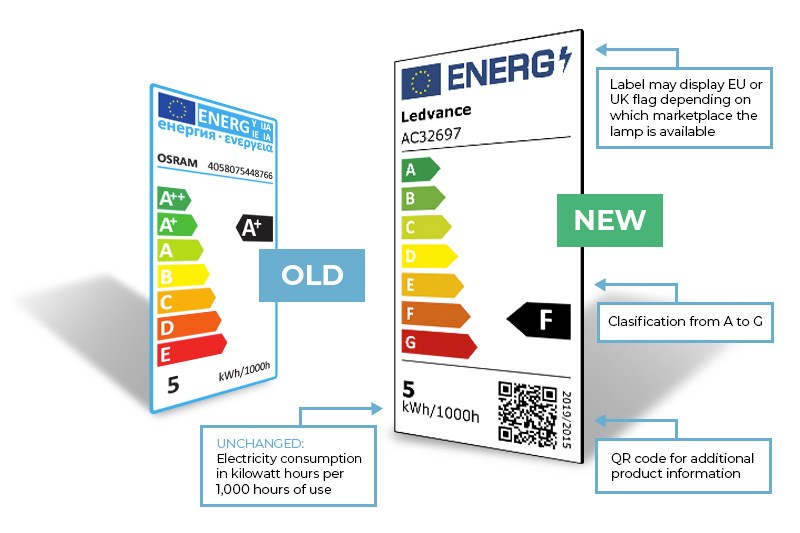
Based on the energy efficiency achieved, each light source will be given a new classification and a new rating between A and G. In addition to this, some products will not be permitted to be placed on the market in the EU. Please note that existing stock with the old label may still be sold until 1 March 2023.
New LED light bulbs are becoming more and more energy-efficient. Almost all new LED products are labelled in the top categories (A++, A+, A). Rather than adding more plusses to the A class, the new letters have been “rescaled”, to a simpler A to G scale.
Although the energy rating scale has changed, the product itself is still the same and will still consume the same amount of energy. This also means the light bulb will cost the same to run as it ever did
It is worth noting, that although the energy efficiency rating may have changed (for example A+ to F), the energy efficiency of the product has not changed, only the letter to which it is designated.
This new, simpler system will not only make it easier to know which light bulbs are the most energy-efficient, but it will also allow more room for innovation. That’s because the current most efficient light bulbs will now be rated as an F or a G in the new rankings, meaning manufacturers have more opportunity to build even more efficient light bulbs in the future.
Labelling: the alternative
From September 1, 2021, and in accordance with the new energy labelling regulations, all EU light sources must be listed in the EPREL database (European Product Database for Energy Labelling) or (for UK products) the manufacturers specification information where they will be assessed and relabelled on the basis of ecological and sustainable aspects.
The QR code on the label links to data stored in the EPREL database/UK manufacturers specifications. By scanning the QR code featured on the new energy labels you can access information such as the luminous flux, the colour temperature and the cap type.
What’s on the new energy labels?
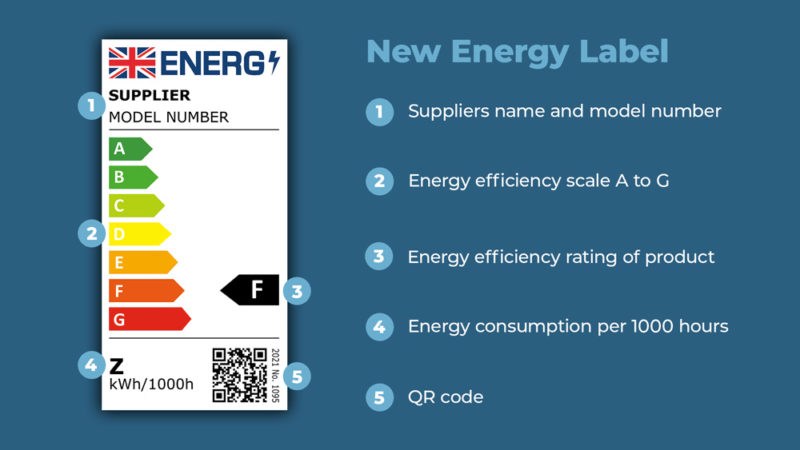
SLR/ELR: the most important changes to energy labels
- All light sources are evaluated in accordance with the regulations
- The packaging and graphics you see will have been adapted slightly
- All light sources are included in the EU wide EPREL database
- There’s a brand new energy efficiency label. The scale has changed from “A++ to E” to “A to G“.
- Existing stock can be sold without reclassification until March 2023.
In recent years, you may have noticed that electrical appliances and light sources have become more and more energy-efficient. Because of this, most appliances were considered efficient and there were hardly any differences between the energy efficiency ratings A+, A++ and A+++. The new energy label has been introduced to make the differences far clearer.
A+, A++ und A+++ ratings no longer exist on the new EU energy label. The new scale runs from A to G. We explain about rating A further down this blog, but for now ratings B and C are the ‘best in class’ and most energy-efficient lights. You may have noticed the QR code which is also new. This gives the customers direct access to the European Product Database for Energy Labelling (EPREL), in which further product information is available. This registration is mandatory for manufacturers.
No. They are still the same energy-efficient light as before – only the designated letter has changed. The new test procedure is incredibly stringent and also considers future lighting efficiency improvements. In short, the efficient products under the old energy label are just as efficient with the new one.
Most electrical appliances that you will now see, have an old EU energy label and a new one. In addition to light sources, these include, things like TVs and home appliances, such as washing machines and refrigerators.
If you have any questions regarding the label changes then get in touch with a member of our team.
For more information on the light bulb ban, read our article The Light Bulb Ban – What and When?
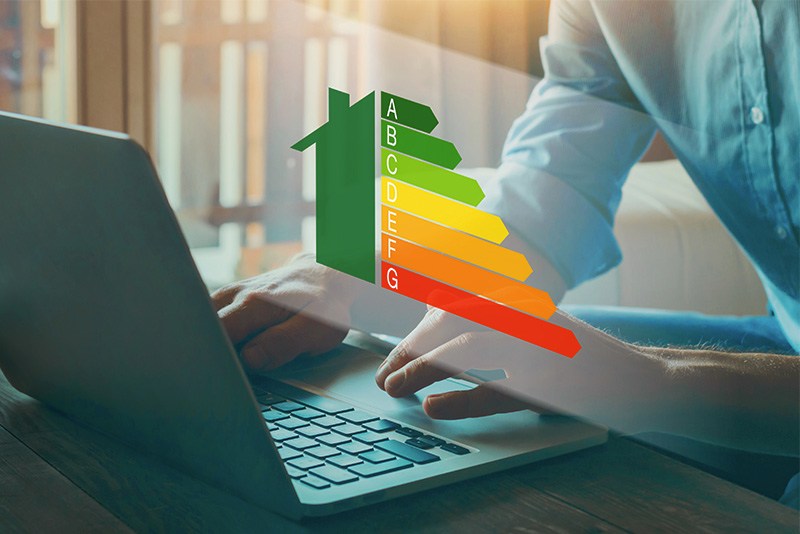

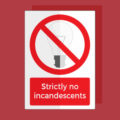

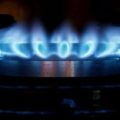
Really confused. So the old A+ is now F rated?
Basically, yes.
I’m finding it difficult to understand whether the bulbs I just looked at are an ‘A’ rating according to the old Energy Rating Scale, or if they are meeting the new code at an ‘A’ rating. I can only presume that these are in line with the old code as I can’t see any others on the market that are ‘A’ rated following the new Energy Rating Scale.Please could somebody answer this for me?
It is now a legal requirement for all sellers (including online sellers) to show the energy label on their product listing pages. In this case, you can identify the new labels as they contain a QR code on the label. Also the new scale uses the letters A to G, whereas the old scale was A++ to E. We understand the confusion this change has caused, so in return we try to make it as clear as possible and state both ratings on our product pages – so you may see wording like “New 2021 Energy Rating: F (A+ Pre-2021)”. For info, we have a small range of A rated ultra-efficient light bulbs for sale which do acheive an A rating on the new scale. We will be expanding on this range in the new year to include all the common light bulb shapes and sizes.
So which ones are the most efficient? It looks like F but surely that is just confusing!
‘A’ would be the most efficient. We have a small range of A class LED bulbs and will be expanding this range in May 2025.
The confirmation of the shift of range of efficiency ratings is very helpful, as I had been thinking that must have happened. However there is an error in the English used. The word transition is a noun, not a verb. The phrase should be ‘to undergo transition’. To do otherwise is sloppy.
Transition may be a noun or a verb. The addition of ‘undergo’ to turn the verb into a noun is called nominalisation and makes the sentence overly formal.